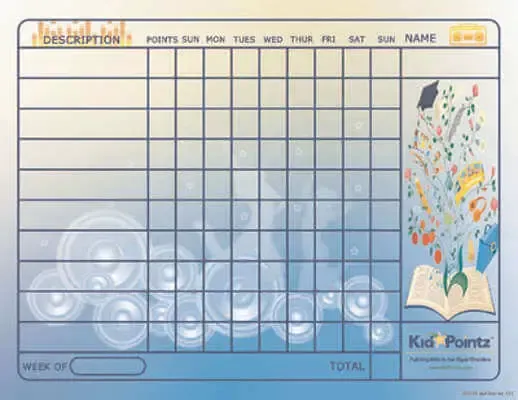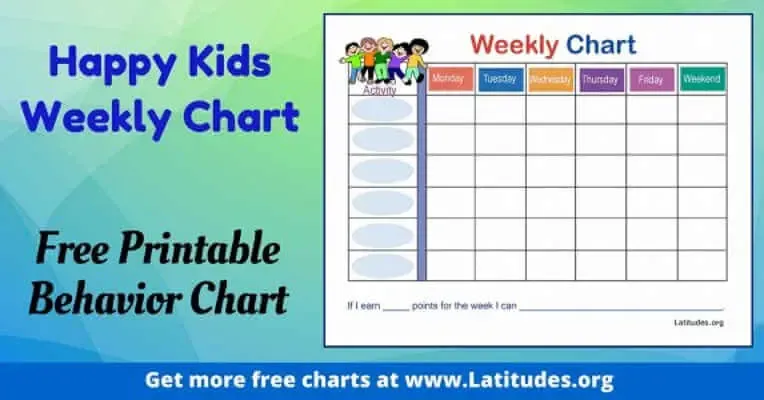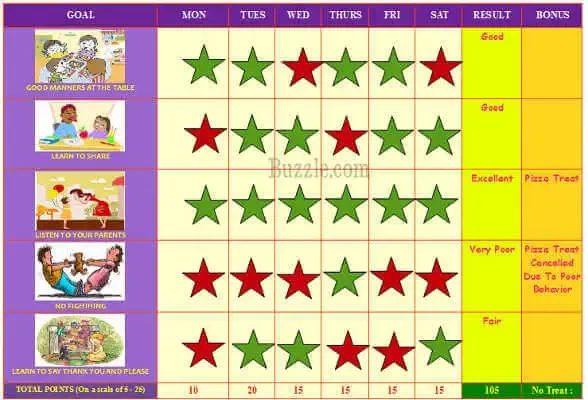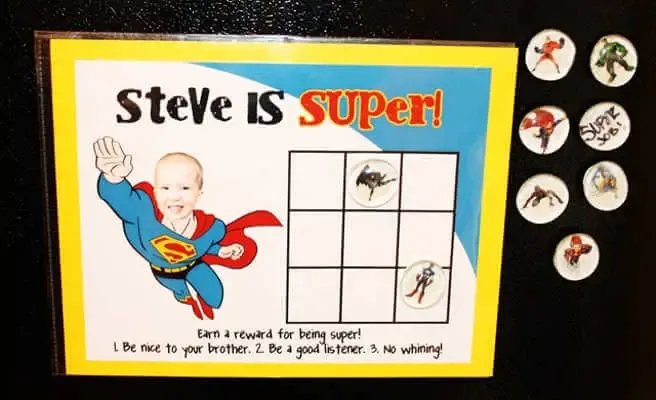Positive Reinforcement for Kids: 11+ Examples for Parents
 Children don’t come with instructions and discipline is often experienced by parents and children alike as an arena where our will and wits are tested.
Children don’t come with instructions and discipline is often experienced by parents and children alike as an arena where our will and wits are tested.
Positive reinforcement is only one of many forms of discipline, but from the perspective of positive psychology, it may as well be the most important one as it focuses on amplifying what is already good in our children and in ourselves as their caretakers.
Positive reinforcement as a form of positive discipline allows us to tap into our children’s individual strengths, draw attention to their personality traits and interests, and as a result give us an opportunity to connect, communicate effectively, and ultimately empower them to be more of themselves.
Before you continue, we thought you might like to download our three Positive Relationships Exercises for free. These detailed, science-based exercises will help you or your clients build healthy, life-enriching relationships.
This Article Contains:
- A Look at Parenting with Positive Reinforcement
- 11 Examples of Positive Reinforcement at Use
- Using Positive Reinforcement to Change Children’s Behavior
- Does it Work?
- Research and Studies
- What are the Benefits and Advantages?
- Are There Any Dangers?
- How to Use Positive Reinforcement with Toddlers
- Techniques and Ideas for Kids
- Techniques and Ideas for Parents and Teens
- Positive Reinforcement Behavior Chart (PDF)
- More Charts to Use with Toddlers
- A List of Positive Reinforcement Words to Use
- Books on Positive Parenting
- A Take-Home Message
- References
A Look at Parenting with Positive Reinforcement
Education is teaching our children to desire the right things.
Plato
Positive reinforcement is one of four types of reinforcement in operant conditioning theory of human behavior (see our article on Positive Reinforcement in Psychology) and one of many approaches to parenting. It is intended to encourage a desired behavior by introducing rewards shortly after the occurrence and therefore increasing the likelihood of repetition (McLeod, 2018).
It’s not unlike the fundamental principle of positive psychology which stresses the need to focus on what is good in human nature. And just like positive psychology does not claim to represent a complete view of human psychology, the use of positive reinforcement alone does not make for an effective model for parenting but is rather complementary to it while taking a central stage in many contemporary models of positive parenting discussed below.
The aim of Positive Psychology is to catalyze a change in psychology from a preoccupation only with repairing the worst things in life to also building the best qualities in life.
Martin Seligman (Seligman & Csikszentmihalyi, 2000, p. 5).
Positive reinforcement can be used to encourage behaviors we want to increase, like your child cleaning her teeth without a fuss, or to reward your child for practicing new skills and can encourage him to continue, like tying his shoes or loading a dishwasher.
Long-Lasting Positive Reinforcement
For positive reinforcement to be effective and of long-lasting value, it may require a change of habit on the part of the parent as much as it is intended to change the behavior of a child. Some of us will have to develop a muscle not only to praise versus criticize but also to praise well, and it may not feel natural at first.
For many parents the natural tendency to correct and fix behavior problems was ingrained in their own upbringing and is usually well-intentions, but over-reliance on this approach deprives us of the many opportunities to notice what our children already do well.
There is no such thing as a perfect parent. So just be a real one.
Sue Atkins
As research in positive emotions by Barbara Fredrickson shows that the ratio of 5 to 1 in positive to negative emotions contributes to happiness, a similar ratio of positive reinforcements to other forms of correcting behavior (like negative reinforcement or positive punishment) should also yield better results, and ultimately happier children and parents (Fredrickson, & Losada, 2005).
Following this model, the use of positive praise for example should outweigh instances of criticism 5 to 1 to increase positive affect and well-being, both in children and their parents (Rodriquez & Sprick, n.d.).
Growth, Development, and Self-Efficacy
The most important aspect of effective praise is to complement the behavior not the person. Professor Carol Dweck of Stanford University explains how praising the effort versus the personality of the child supports a growth mindset and a sense of self-efficacy.
Her well-known book Mindset: The New Psychology of Success which explains the roots of intrinsic motivation, stresses the importance of focusing on the child’s ability to pursue goals and commitment to learning new skills which is within his control over inherent qualities like personality which are a given and often difficult to change (2007).
Your kids require you most of all to love them for who they are, not to spend your whole time trying to correct them.
Bill Ayers
Affection is also extremely important in how we communicate our approval, according to Dr. John Gottman, a long-time researcher into positive family dynamics. His books The Heart of Parenting: How to Raise an Emotionally Intelligent Child (1997) and Meta-Emotions: How Families Communicate Emotionally (2013) list many practical tools for improving emotional connection with our children even in the toughest of moments and remind us that expressions of warmth and compassion communicate authenticity and enhances closeness.
Autonomy, Competence, and Relatedness

A sense of autonomy can be supported by involving our children in setting limits and offering choices for rewards that connect to what is a meaningful and enjoyable form of recognition for our children.
For that, we must be closely attuned to our children’s interests and have a good map of their emotional worlds, a worthwhile investment that supports their basic need for connection.
The good life is best construed as a matrix that includes happiness, occasional sadness, a sense of purpose, playfulness, and psychological flexibility, as well autonomy, mastery, and belonging.
Robert Biswas-Diener
Many respected authors on positive parenting, like Dr. Dan Siegel, suggest we should take interest in our child’s pursuits by being curious, even if at first it may not seem like something that is our cup of tea (2016). Being open-minded and suspending judgment long enough to get to know our child can be a learning opportunity both for the parent as much as the child.
Finally, a child’s sense of competence can be fostered by reinforcing behaviors that speak to their strengths and can be cultivated through creating opportunities for mastery of skills and practice of perseverance and commitment.
Jessica Lahey, in her wonderful book The Gift of Failure: How the Best Parents Learn to Let Go So Their Children Can Succeed, warns parents that overprotective failure-avoidant parenting style undermines competencies, independence, and academic potential and could lead to a life of anxiety (2015).
Where parents do too much for their children, the children will not do much for themselves.
Elbert Hubbard
Safe and overprotected children make parents feel good about themselves. When we are enmeshed in our children’s lives, we send them a message that they are incompetent and stifle their creativity.
Lahey reminds us that children learn to be resourceful and innovative as a result of failure because it requires intellectual and emotional bravery from the child and a lot of support, love, and a lot of restraint on the part of the parents. Failure fosters grit, supports autonomy, and competence, helps parents learn to back off and see the big picture and even teach them to embrace the opportunity to fail (Lahey, 2015).
11 Examples of Positive Reinforcement at Use

Positive reinforcers are also widely used in school settings and child care centers to entice children to perform a task, learn a new skill or exhibit a desired behavior more frequently or on time, and can be just as effectively be replicated at home.
Some of the obvious examples of positive reinforcement used in schools that can easily translate to parenting scenarios include:
- Compliments and recognition
- Public praise, positive notes to parents and teachers
- Pats on the back, smiles, handshakes, and high-fives
- Being the teacher’s helper or choice of classroom chores
- Reading, making crafts, playing sports, or other preferred activity with someone special
- Extra credit or bonus points on school work
- Posting work in a place of honor
- A homework-free night
- Choice of activities
- Time or lunch with someone special
- Increased recess time
Children of all ages respond well to praise as they want to please their parents and more often want to be seen as making good choices. When we praise positive behaviors and choices, we empower our children to repeat them. Catch your child in the act of being ‘good’ and when your she is behaving in a way you like, give her some positive feedback.
For example, you can tell her “I really like the way you’re keeping all the blocks on the table,” which works better than waiting for the blocks to come crashing down before you take notice and say, “Be careful.”
This form of positive feedback known as descriptive praise because it tells children specifically what they’re doing well. Our lives are full of ambiguities as children’s author Shel Silverstein who explains in his short poem:
When the light is green you go
When the light is red you stop
But what do you when the light is blue
With orange and lavender spots
(133).
Remember to make at least five positive comments for every negative response because if children have a choice between no attention or negative attention, they’ll often settle for getting a raise of out you.
Descriptive encouragements are powerful motivators. Even teenagers, who might seem self-sufficient, still want and need your approval. When you notice your older child’s responsible choices you encourage her to keep behaving that way but be sensitive to the fact that teenagers often prefer you to be praised privately rather than in front of their friends (Belsky, 2008).
With teenagers giving more privileges or increasing responsibilities can also be a very effective form of reward. We must be willing to discuss and adjust rules as our children show greater sense of responsibility and get older, for example, by extending a child’s curfew.
Using Positive Reinforcement to Change Children’s Behavior

Frequency and Consistency
When using positive reinforcement to change behavior immediacy, frequency and consistency is very important. When a child is learning a new skill providing reinforcement right away and often keeps them motivated and committed. Here is where reinforcement schedules come in handy.
- Continuous schedule of reinforcers introduced consistently after every occurrence of desired behavior while not easy to maintain represents operant conditioning at its most intense and effective.
- Reinforcements can also be given at a fixed ratio after a specific number of occurrences or fixed intervals after agreed-upon amount of time.
- Finally, variable schedules can be introduced when where we offer rewards less frequently as time goes on so as to prevent the dependence on rewards in favor of fostering of internal motivation to perform the desired behavior (NAEYC, 2018).
Monitoring progress is also crucial so adjustments can be made based on the child’s preference for the type of rewards. Soliciting a child’s preferences can itself enhance motivation by introducing a choice and therefore fostering a sense of autonomy.
Monitoring for satiation can help to prevent reinforcers from diminishing in power. Here we can offer more variety by switching the reward systems, by adjusting the sessions of reinforcements from continuous to intermittent, especially after the desired behavior is established.
What Rewards Are Best?
The type of rewards we provide is also very important and depends on the context as some of them like natural reinforcers occur naturally as a consequence of a child’s behavior and may not require our intervention.
- Natural reinforcers in the form of good grades or a sense of self-satisfaction for a job well done are most effective as they support self-esteem, sense of agency, and increase intrinsic motivation.
- Social reinforcers like recognition or approval of others that can be expressed through compliments, encouragement, and specific praise are also very powerful as they communicate acceptance and belonging.
- Token reinforcers that are offered in place of tangible rewards can also be effective in encouraging progress toward goals as they can be used immediately and are an effective visual representation of continuous effort. A child can earn points or accumulate token which they can then trade-in for something of value to them.
- Finally, tangible rewards can be used to kickstart motivation, but satisfaction in the job well done should be stressed. We want to use rewards to restore motivation not to make them the object of pursuit, so the children don’t become dependent on rewards.
If we’re trying to extinguish rewards, we want to wait before we reward by gradually decreasing the frequency or by extending the length of intervals between the introductions of positive reinforcers to disconnect the task from the reward (Lynch, 2017).
Positive Reinforcement Checklists
Here is a soup to nuts positive reinforcement checklist (PDF) with suggestions for reinforcement schedules that can be used for younger kids. It’s geared toward teachers but can be applied just as effectively at home.
While sensory, natural, or social reinforcers are of more lasting value, when it comes to younger children tangible reinforcements may be used to add variety, increase the immediacy and frequency. Tangible rewards should always be tied to values and behaviors we are trying to promote.
Some of the helpful techniques for use with younger children are communicating through pictures and displaying reinforcers briefly to encourage pursuit as out of sight can often be out of mind.
Does it Work?
The short answer is yes it does, but there are caveats to using positive reinforcement effectively because they represent only a part of what constitutes positive discipline.
According to Jane Nelsen Ed.D., who had been writing on positive parenting since the 1980s, positive discipline tools eliminate the need for punishment and prevent the potential damage that can be caused by permissive parenting (Gfroerer, Nelsen, & Kern, 2014).
Her positive discipline model is based on kindness and firmness at the same time. It encourages parents to provide opportunities for children to develop in areas that will strengthen their perceptions and skills in core aspects of life by asking curious questions and involving children is setting limits. The seven core perceptions and skills we should be fostering in children, according to Nelsen, include:
- Sense of agency and personal capability that child can handle most things in life
- Strong perception of one’s importance in primary relationship and feeling genuinely needed and contributing
- Belief in being able to influence what happens to them and sense of personal power away from learned helplessness
- Intrapersonal skills that involve self-understanding, emotional intelligence, and self-discipline
- Interpersonal skills of communication, active listening, empathy, cooperation, sharing and negotiating
- Systemic skills of responsibility, integrity, adaptability, and flexibility
- Judgment skills and the ability to evaluate situations in accordance with their values (Gfroerer, Nelsen, & Kern, 2014).
Nelsen’s Positive Discipline Handbook explains that there are several pieces to the puzzle of positive discipline and that understanding of reasons for misbehavior, acceptance of mistakes as an opportunity to learn, cultivation of mutual respect, and shared problem-solving are a must.
Research and Studies

Today schools, clinical practice, and parent education programs apply these methods to their design of tools, curricula and interventions that support the development of a child’s sense of belonging and the development of life skills (Holden, 2010).
More recently developed programs like the Triple P – Positive Parenting Programs of professor Matt Sanders, include assertive discipline with clear ground rules and expectations reinforced by consistent discipline where positive reinforcements complemented by non-physical punishments like time-outs are encouraged and represent widely used methods in 25 counties (Sanders, 1999).
A large number of research studies have been done applying the Triple P program, mostly in educational settings but also to parenting programs and clinical settings with considerable success (Gfroerer, Nelsen, & Kern, 2014).
The kids who need the most love will ask for it in the most unloving ways.
Russel Barkley
Other positive discipline methods expend on the positive parenting approach by stressing the long terms goals of parenting, providing warmth and giving structure, supporting learning, and problem-solving rather than reacting with discipline. Prominent programs of this kind include that of Joan Durrant, a Canadian child psychologist and Save the Children Sweden (Durrant, et al 2014).
Today Positive Discipline Every Day program offers training in 30 different countries and there are more than 70 different adaptations of the positive discipline that avoids all punishment, encourages positive rewards, and promotes cooperative relationships based on warmth.
These approaches recommend being proactive in avoiding conflict, staying calm, attending selectively to misbehavior, apologizing when appropriate, and using humor to defuse difficult situations (Durrant, et al 2014).
Finally, there are alternative perspectives on the level of influence parenting has on the development of children. Dr. Judith Rich Harris in her ground-breaking 1995 Psychological Review article Where is the child’s environment?
A group socialization theory of development argued that parental socialization has minimal effect on children because they are mostly influenced by their peers and socialized by their environment.
What are the Benefits and Advantages?

While our natural tendency is to correct, fix and problem solve it often does not make for a more effective approach and tends to alienate those we’re trying to help.
Many would agree that it is far more enjoyable to be praised and appreciate our children for what they already do well rather than constantly criticizing them. While honesty and constructive feedback are important, so is the right balance between praise and other forms of discipline.
Positive reinforcement also allows parents to avoid the long-term negative consequences of punishment which are not always immediately visible. These techniques can also improve the attachment and parenting bond in parent–child relationships.
Over time punishment creates resentment and diminishing trust, rebellion, and even revenge which encourages the children to be defiant and do the opposite of what we ask. Some may retreat into themselves and start to hide and lie, and in other instances internalize the act of punishment and think of themselves as a bad person.
Making the decision to have a child—it’s momentous. It is to decide forever to have your heart go walking outside your body.
Elizabeth Stone
Finally, as Dr. John Gottman explains, many of the difficult moments when we discipline our children are also teaching moments that, when approached with gentle kindness, can be used to foster greater connection and help our children learn from their mistakes (2018).
Emotional intelligence is at the heart of effective parenting and while managing emotions can be difficult for many adults, it is our job as parents to teach and model for our children how to manage and cope with overwhelming emotions. His method for emotions coaching for kids suggests that we:
- Describe behavior in terms of what we see and only then say how we feel about it
- Model behaviors we want them to imitate and do not contradict it e.g. by yelling
- Apologize
- Respect their needs
- Validate their experience
- Help them solve problems
- Think before we say no.
Many of us come from families of poor communicators where we were thought that negative emotions were not OK. Gottman reminds us that while not all behaviors are appropriate all emotions are normal, and we want to acknowledge and validate them so that our children do not learn to define themselves through their missed steps (2018).
Are There Any Dangers?

It is hard to argue however that many Western cultures are quite materialistic and driven by consumerism. Christine Gross-Loh in her eye-opening book Parenting without Border: Surprising Lessons Parents Around the World Can Teach Us lists many examples where children living in nations that de-emphasized money and prioritized egalitarian values enjoy greater well-being (2013).
Around The World
In Korea, it is a cultural norm to live near or with extended family, while in Japan being a good parent is equivalent to teaching children to be frugal, resourceful, and restrained in their desires.
Although in Sweden kids are given a lot of choice from the time they are young, their parents and teachers guide those choices and constantly explain to kids what a good choice is. Countries like Sweden are examples where families benefit from generous parental leave policies and less advertising aimed at kids.
Many French parents argue that real value is found in what we purchase but in the sense of family warn that giving children what they want all the time puts them at risk of always needing to have more. One of the mothers Gross-Loh interviewed said:
“But I think that ties into French discipline generally,” she mused, “where all is to be thoroughly enjoyed—with strict limits and at the proper time, and where excess and gluttony are taboo. There is really something to be learned from this, at the table and at the toy store.”
Similarly to overusing rewards, it is possible to take positive praise too far and Gross-Loh warns that our children can become slaves to praise. Many Asian cultures view American style of parenting as overly-focused on self-esteem while not fostering enough community and belonging.
She argues that telling our kids how great they are or constantly complementing then on how wonderfully they are doing can make them blind to opportunities that would allow them to experience the challenges that are necessary to build resilience.
A confident, competent and happy child would have usually grown up having many chances to build up the genuine reserves of self-confidence through mastering difficult tasks on her own not as a result of an overinflated sense of self, according to Gross-Loh (2013). (See: Building resilience in children)
Finally, excessive praise can be exhausting, and our children can tell when we’re not being genuine. We risk losing credibility if we praise them indiscriminately. Not to mention that we also run a risk of reinforcing a wrong behavior, even if unintentionally.
How to Use Positive Reinforcement with Toddlers

According to the National Association for the Education of Young Children, toddlers do not have the cognitive ability to understand reasoning and lengthy explanations, so parents need to have a realistic expectation when it comes to using reinforcement with younger children and plan ahead for the inevitable meltdowns (2019).
Remembering that toddler aggression is a normal part of their development and that it often stems from lack of language skills, a desire to be more independent, low frustration tolerance, exhaustion, hunger, a change in routine, or boredom is a good place to start (Florez, 2011).
Young children act out when they need more attention. Using attention to improve toddler behavior can be particularly effective. Positive attention is about noticing what your child is doing and letting him know that you’re pleased. This can be done through:
- praise
- encouragement
- physical affection or gestures
- active listening
Positive attention works best when it is used often, rather than occasionally so that the child is reminded often of the kind of behavior you want them to repeat more often.
Praising good behavior is particularly important for when a child is learning a new behavioral skill or has found one to be difficult to learn. Here we can praise the effort as well as the instances of successful exhibit of desired behavior. Most importantly, positive attention can be given anywhere and almost anytime and over time allows us to get into a habit of looking for positives.
Psychotherapist Katie Hurley of Practical Parenting beliefs that even toddlers can handle responsibilities when you can make a game and a privilege out of performing tasks around the house. Counting and sorting can be fun for toddlers as can preparing snacks. Follow up with praise and encouragement immediately and reinforce the wonderful behavior in a positive way.
Listen actively especially because your toddler’s ability to vocalize can be a source of mutual challenge. You can nod as your child talks to make feel respected and comforted. When you do this, it can help young children cope with tension and frustration, which sometimes leads to unwanted behavior and diffuse potential temper tantrums.
Be firm when using positive reinforcements with toddlers. It requires a lot of patience and can be tricky, particularly when they whine and the urge to give in is hard to resist, but when we fail to be firm and consistent we can accidentally reinforce the wrong behavior and train her to whine more (Cherry, 2018).
Managing Unwanted Behavior
The beautiful thing about raising toddlers is that redirecting attention is still an effective way to prevent upsets. PBS Kids website suggests that when the child is misbehaving turn their attention to something positive they can do or enlist their help with and distract from the trigger of unwanted behavior (2018).
Having children is like living in a frat house—nobody sleeps, everything’s broken, and there’s a lot of throwing up.
Ray Romano
Remove the trigger, if what is causing the child to misbehave can be put away like a toy that causes a lot of fights, ask your child to choose a place where you can put it away for a time. Although one of the hardest skills to learn, sharing is also one of the most important social skills to teach. Many parents use a timer to help toddlers work on trading toys after two minutes.
Shifting Focus and Planning Ahead
Shifting focus when toddlers act out for attention can also be a great opportunity to spend quality one-on-one time with your child. This is a perfect time to tune in, get close, and regress into your inner child. A worth-while investment for a busy parent and an opportunity to take a step back and decompress yourself (Copple, & Bredekamp, 2008).
Prepare for challenging situations as there are times when looking after your child and checking things off your to-do list will be tricky. Plan in advance and around your child’s needs. Giving a five-minute warning before you need him to change activities can work wonders to prepare him for what’s coming next.
Finally, when inevitable tantrums strike and nothing seems to work it may require that parents remove the child from the situation to give him a chance to decompress away from the trigger. Reframe the concept of time out and call it a relaxation break.
And let’s not forget humor, a secret remedy for many a bad mood that can make even picking up one’s toys a lot of fun when disguised as a session with a tickle monster.
14 Techniques and Ideas for Parents and Their Kids
The following suggestions come from the National Association for the Education of Young Children (NAEYC).
Based in Washington, DC, it awards accreditation to early childhood associate, baccalaureate, and master’s degree programs that demonstrate evidence of excellence by meeting the NAEYC Professional Preparation Standards and from the Raising Children Network (RCN) funded by the Australian Government Department of Social Services Families and Children Program.
Working with over 200 top Australian and international experts made-up of some of Australia’s pre-eminent experts in child health and development, RCN provides the most up-to-date research by partnering with highly respected content partners, including the Centre for Adolescent Health, Victorian Department of Education and Training, NSW Kids and Families and Stepfamilies Australia approved by our Scientific Advisory Board.
Below are some things to keep in mind while employing positive reinforcement as many of these strategies enhance and support the use of positive discipline. Everything from the environment, structure, personalities, and awareness of our own and our children’s triggers can get in the way of noticing and responding to opportunities for positive parenting.
1. Create an environment that fosters good behavior.
The environment around a child can influence his behavior so it should be shaped in a predictable way that helps him behave well. Making the child’s space organized, safe, easy to maneuver, and filled with stimulating things to play and engage with. If possible, provide natural light and space dedicated to school work for older children.
2. Provide structure and clear limits.
It is important to have house rules that are well-understood, reasonable and adjusted by age. The limits should be continually stressed, both verbally and through visual reminders in a prominent place with pictures for younger children.
Most children respond well to a structure so try to stay on schedule as much as possible so that kids, especially younger ones, know what comes next. With older children, involve them in setting family rules to empower them to be active participators in running of the household.
3. Teach them about natural consequences.
From the youngest age, children can see that their choices have negative results and can get upset by the natural consequences of their actions. But remember that younger children can understand consequences only if they experience them. For example, if it’s your child’s responsibility to pack for a sleepover and she forgets her favorite pillow, she’ll have to manage without it for the night.
Sometimes that will be enough so no further intervention is necessary, at other times you may have to help them choose a positive replacement behavior instead or help them problem-solve and find ways to fix the situation to relieve that feeling of helplessness.
At other times you and your child may have to agree on the consequence to the broken rule in advance. And most importantly, follow up calmly, firmly, and consistently when rules are broken.
4. Be a role model.
It’s important to send a positive message and be a good role model as our children from a young age watch us for clues on how to behave and signs of not practicing what we preach. As the saying goes, they will do as you do not as you say. For example, if you’re trying to cultivate a positive self-image in your child avoid making negative statements about yourself or others in front of your kids.
Your children will become what you are; so be what you want them to be.
David Bly
5. Pick your battles carefully and learn to live with mistakes.
Ask yourself how much opportunity for conflict and bad feelings getting involved in everything your child is doing can potentially create and ask yourself if it really matters.
Rules are important, but if you spend all your time instructing, correcting, and saying no, perhaps it’s time to re-evaluate. Saying sorry to your child when you make a mistake teaches them to take responsibility and helps to keep your relationship going well.
6. Parent according to personality.
All children are different. Remember that you might have to tailor your intervention style to each child. While positive reinforcement tends to work across the board, playtime might work better for one while relaxation breaks could be better for another.
7. Be open to discussion.
When a child comes to you with her own perspective on something unpleasant like noticing that another child does not like them, resist the urge to deny their feelings and say “No, she doesn’t”. This kind of response shuts down the conversation. A better strategy is to ask follow-up questions “What makes you think that she doesn’t like you?”
Help your child explore alternate explanations for what happened and encourage them to problem solve if age-appropriate.
The way we talk to our children becomes their inner voice.
Peggy O’Mara
8. Model emotional intelligence and show your child how you feel.
An honest conversation with your child about how his behavior affects you helps him see things from your perspective and understand his own feelings and yours. Use ‘I’ statements when talking about your feeling, describe the behavior not the person and make a request for what you want them to do instead. Involve older children in problem-solving and coming up with alternatives.
9. Follow through and keep promises, good or bad, to foster trust and cultivate mutual respect.
She learns that she can rely on you and you won’t let her down when you’ve promised something. She also learns not to try to change your mind when you’ve explained the natural consequences of her behavior. Explain the consequences, and if appropriate ask your child to agree to them in advance.
Finally, when you let her experience the consequences for herself, she learns to disassociate you as the source of discipline.
10. Delegate responsibility to make your child feel important.
For younger children give them some simple chores or things that she can do to help the family. Allow her lots of practice doing a chore so she can get better at it and praise for her behavior and effort to build her self-esteem.
11. Reframe toward the positive.
Whenever possible tell them what you want them to do versus what you don’t want. Positive rules are usually better received than negative ones because they guide your child’s behavior in a positive way instead of making them feel like you’re anticipating they will do the opposite. For example, ‘Please shut the door’ is better than ‘Don’t leave the door open’. The same applies to setting rules.
The power of positive re-inforcement – Wendy Smith
Techniques and Ideas for Parents and Teens
Good behavior in teenagers starts with positive communication and a warm relationship. Some of the practical tips below cover communication, rules, role-modeling, problem-solving, praise, trust, and more.
Plan ahead for difficult conversations.
To avoid conflict and hurt feelings, think ahead how what you’ll say and how your child might feel when you need to have difficult conversations. Arranging a time and place where you can have some privacy also helps. For example, “Izzy, I’d like to make time to talk with you about some things that are happening around the house. We can talk about it over pizza on Saturday night. OK?”
Stay connected through family rituals.
Like family pizza nights, pancakes for breakfast on Sundays, or particular traditions for celebrating birthdays but also through moments that are casual and unplanned, like when your child decides to tell you about her day at school over the washing up. When these moments happen, try to stop what you’re doing and give your child your full attention. This sends the message, ‘You’re important to me and I love you.’
Respect your child’s privacy.
Teenagers crave privacy and to have a space and things of their own. Show respect by asking for your child’s permission to enter his room, and not going through his phone or belongings. Ask yourself how much do you really need to know, and what can be left as private between your child and his friends.
Positive Reinforcement Behavior Chart (PDF)
Behavior charts are a great way to implement positive reinforcement in a tangible and consistent way. Children of all ages like to earn stuff and just like adults they take pride in reaching their goals. Reward charts can also help as visual reminders for parents and children to focus on the positives in the child’s behavior and clarify expectations. They can also motivate by allowing everyone to track the child’s progress towards goals.
“A problem well defined is a problem half solved” – Proverb
Reward Charts
Reward charts are a powerful way of to increase positive behaviors by:
- Encouraging behavior you want, like cleaning teeth without fuss, sharing, completing chores, using kind words, being friendly versus teasing; and
- Rewarding your child for practicing new skills, like staying next to the trolley when shopping or putting all the toys in a box when asked.
When you’ve decided on your chart, decide which stickers or tokens to use. Star stickers work well for younger children, whereas older children might like points or other markers.
Put the chart where your child can see it. Keep in mind that your older child might prefer a spot that’s private – for example, in her bedroom rather than on the fridge.
Kid Pointz website has a large number of free printable and customizable charts as the one below.

Another website Association for Comprehensive NeuroTherapy (ACN) has wonderful rewards charts for 3 to 8 year old and includes wall posters and apps.
Do’s and Don’ts of Reward Charts
Here are some dos and don’ts of an effective behavior chart and reward systems:
- Make it clear what behavior you are working to change
- Identify the prize ahead of time
- Identify how many stickers need to be saved up for the reward ahead of time
- Make the prizes achievable
- Use meaningful rewards that the child wants to receive
- Keep your child’s eye on the prize by reminding or displaying it
- Be consistent
- Connect the sticker to the targeted behavior by rewarding right away
- Be positive and do not take away the stickers if your child misbehaves
- Think of this as a reward, NOT as a bribe.

Older children might like to create their own chart based on what you’ve agreed to. They can include a drawing or photo of the reward they’re trying to earn. Another good option is a reward chart apps on your or your child’s phone. They are easy to use, convenient and portable and let you give your child points as soon as he earns it, even on the go.
More Charts to Use with Toddlers
Limited linguistic abilities of toddlers can provide an interesting opportunity for parents to be creative in their ability to communicate. If most of our communication is non-verbal there is no better way to test this out then with toddlers.
Behavior charts for toddlers work best when they are a visual extension of the positive reinforcement your child already receives from you on a daily basis like praise or high fives.
There is no right or wrong age to introduce a behavior chart. If your toddler doesn’t seem to grasp the concept or respond to the incentives, you can put it away and then try again in a few months.
Start small and stick to three to five things, arranged in the order she usually completes them throughout the day. For better results allow your child to be the one who places the sticker or magnet on the chart.

When we get discouraged it helps to remember how malleable and easily influenced children are in early childhood so whatever effort we put into discipline and teaching is bound to pay off dividends in the long run.
Many websites have encouraging and happy free printable behavior charts as well as tips on how to use them effectively. You can customize them or simplify them to a single behavior chart like one for potty training.

A List of Positive Reinforcement Words to Use
Here are some examples of how to use positive reinforcement through effective praise and encouragement while keeping in mind that all communications are more effective while our body language is in line with what we express verbally:
- Your turn is coming. I am so proud of how patient you are.
- I have seen you say that in a respectful way.
- I care about you and will wait until we both can be respectful to continue this conversation
- I know you can think of a helpful solution
- Good sharing, Tyler. Keep trying.
- Wow, you put both arms in your coat all by yourself!
- Thank you for telling me your diaper needs changing.
- Thanks for coming straight home from the movie.
- Wow, I’m so impressed you’ve been getting ready for school on time lately. I think we’ll go to the playground tonight to celebrate
- You were so quiet with your puzzle while I was finishing that paperwork, just like I asked.
- What bright, happy colors you picked for the dog’s spots.
- I see you drew a picture of the story that we read this morning.
- I get worried when you stay out late without telling me what you’re doing. Next time, I’ll pick you up at 10 pm.
What could you do differently next time so you don’t get a consequence?
With teenagers, a much more comprehensive approach can be used. Here are a few examples of how we can use the Appreciative Inquiry process to encourage our “soon to be adults” to self-reflect. The core principles of AIA process are: Appreciating the Present, Imagining the ideal, and Acting now in alignment.
The purpose of these steps is to help the teenager feel good about the current situation or person, get clear about what they want, and take action that aligns with their ideal future. The AIA process keeps us on course by asking three things in our daily interactions and experiences:
Appreciating:
- Do you feel appreciative or good about this situation or person?
- If not, are you focusing on what you don’t want in this situation?
- How can you shift to see more of the good or more of what you want?
Imagining:
- Are you clear about what you want?
- Is this where you’re giving your attention?
- Your feelings again provide helpful information. If you’re not feeling good, are you focusing on what I want?
Acting:
- Do your current actions and thinking align with what you want?
- Is what you’re saying, thinking, and doing consistent with what you desire?
- If not, what small action can you take that would help you move just a bit closer to your ideal?
Phrases You Should Try to Avoid
Children tend to internalize the messages we send according to Suzette Haden Elgin, Ph.D., founder of the Ozark Center for Language Studies, in Huntsville, Arkansas. Below is a list of phrases we should try to avoid.
1. “Not now, I’m busy”
If we get into a pattern of not paying attention to our children when they are small, then they may be less likely to share as they get older. Not to mention that they also learn bad habit when they do not see their parents take time for themselves.
2. “Why are you so mean to your brother?”
We send powerful messages to our children by labeling them. Young children believe what they hear often without question, even when it’s about themselves and negative labels can become a self-fulfilling prophecy as your child begins to think of herself that way, undermining her confidence.
Even labels that seem neutral or positive like smart or shy either limit or place unnecessary expectations on her. A far better approach is to address the specific behavior and leave the adjectives about your child’s personality out of it.
3. “Don’t be upset.”
All feelings are valid but “It’s natural to want to protect a child from such feelings,” says Debbie Glasser, Ph.D., director of Family Support Services at the Mailman Segal Institute for Early Childhood Studies at Nova Southeastern University, in Fort Lauderdale.
Rather than deny that your child feels a particular way acknowledge the emotion and validate it as there is no right or wrong way to feel in any given moment. By naming the feelings you’re also giving your child the words to express himself and model empathy.
4. “Why Can’t You Be More Like Your Sister?”
Comparing your child to someone else implies that you wish yours were different and can also create resentment between you and the child and the siblings or the person you’re comparing her to. It’s natural for parents to compare their kids, to look for a frame of reference about their milestones or their behavior, say experts but making comparisons does not help to change behavior, it only undermines her self-confidence.
5. “You Should Know Better Than That!”
Learning is a process of trial and error and phrases like this can undermine a child’s willingness to learn and try new things and are neither productive nor supportive. Give your child the benefit of the doubt, and help them brainstorm on how to prevent recurrence.
6. “If you do that one more time, you’re in big trouble!”
Threats have been proven to be an ineffective way to change behavior. The younger a child is, the longer it takes for a lesson to sink in.
“Studies have shown that the odds of a two-year-old’s repeating a misdeed later in the same day are eighty percent no matter what sort of discipline you use,”
says Murray Straus, Ph.D., a sociologist at the University of New Hampshire’s Family Research Lab. Although there is no such thing as perfect strategy, especially with older kids, it’s more effective to develop a repertoire of constructive tactics, such as redirection, removing the child from the situation, or applying of natural consequences.
7. “Wait Till Daddy Gets Home!”
Discipline that’s postponed doesn’t connect the consequences with your child’s actions and is just another form of threat. To be effective, you need to take care of a situation immediately yourself. Passing the buck to someone else also undermines your authority and is putting your partner in an undeserved bad-cop role.
8. “Hurry Up!”
Consider your tone of voice when you implore a child to hurry and pay attention to how often you say it. There’s a tendency to make our kids feel guilty for making us rush and although it makes them feel bad, it doesn’t motivate them to move faster. Paul Coleman, author of How to Say It to Your Kids looks for calm ways to speed things along just so he can say that no matter what he will not yell.
9. “Good Boy!”
Praise is a positive reinforcement at its best and one of the most effective tools a parent has. But when the praise is vague and indiscriminate kids tune it out. They can also tell the difference between praise for doing something rote or simple and praise for a real effort. So praise only those accomplishments that require real effort, be specific, and praise the behavior rather than the child.
Books on Positive Parenting
Should you be interested, please see our extensive list of best positive parenting books.
- The Happy Kid Handbook: How to Raise Joyful Children in a Stressful World by Katie Hurley (Amazon)
- The Gift of Failure: How the Best Parents Learn to Let Go So Their Children Can Succeed by Jessica Lahey (Amazon)
- Contexts for Young Child Flourishing: Evolution, Family, and Society edited by Darcia Narváez (Amazon)
- No-Drama Discipline: The Whole-Brain Way to Calm the Chaos and Nurture Your Child’s Developing by Daniel J. Siegel and Tina Payne Bryson (Amazon)
- Positive Discipline Parenting Tools: The 49 Most Effective Methods to Stop Power Struggles, Build Communication, and Raise Empowered, Capable Kids by Jane Nelsen, Mary Nelsen Tamborski and Brad Ainge (Amazon)
- Raising An Emotionally Intelligent Child The Heart of Parenting by John Gottman, Joan Declaire and Daniel Goleman (Amazon)
- Duct Tape Parenting by Vicki Hoefle and Alex Kajitani (Amazon)
- Parenting Without Borders: Surprising Lessons Parents Around the World Can Teach Us by Christine Gross-Loh (Amazon)
A Take-Home Message
Family relationships are a source of some of the most meaningful and most intense experiences in our lives that provide the joy of belonging through unconditional acceptance, trust and love for one another. And although at times parenting feels like we’ve lost our minds and our children have ran away with it, focusing our energy and attention on what is good in our children can bring out the best in them and in ourselves.
What we pay attention to nurtures or decays the world we create for ourselves and our children.
Your daily life is your temple and your religion, bring with you your all.
Khalil Gibran
While children must know that as parents, we expect certain things from them and their behavior has consequences, we can help them recognize that no matter what happens, our love and concern for them is never in question and they can develop their potential within the safe emotional base.
There is a concept in psychology known as Michelangelo Phenomenon that explains how those closest to us can help shape our ideal self by affirming our potential, encouraging us to express the personality traits we deem valuable and creating an environment where we feel safe to be ourselves (Drigotas, et al, 1999).
“If you can keep your head when all about you
Are losing theirs and blaming it on you;
If you can trust yourself when all men doubt you,
But make allowance for their doubting too; …
Or, being lied about, don’t deal in lies,
Or, being hated, don’t give way to hating …
Yours is the Earth and everything that’s in it,
And—which is more—you’ll be a Man my son!”
Rudyard Kipling
We hope you enjoyed reading this article. Don’t forget to download our three Positive Relationships Exercises for free.
- Belsky, J. (2008). Rewards are better than punishment: Here’s why. Psychology Today. Retrieved from https://www.psychologytoday.com/us/blog/family-affair/200809/rewards-are-better-punishment-here-s-why
- Cherry, K. (2018). Positive reinforcement and operant conditioning. VeryWell Mind. Retrieved by https://www.verywellmind.com/what-is-positive-reinforcement-2795412
- Center on the Developing Child. (2015). The Science of Resilience (InBrief). Retrieved from www.developingchild.harvard.edu.
- Copple, C. & Bredekamp, S. (editors). (2009). Developmentally appropriate practice in early childhood programs. 3rd ed. Washington, D.C.
- Daniels, (2016). Bringing Out the Best in People: How to Apply the Astonishing Power of Positive Reinforcement, Third Edition PDF, ePub eBook. Retrieved from http://isbninspire.com/pdf123/offer.php?id=1259644901
- Diamond, G. M. (2014). Attachment-based family therapy interventions. Psychotherapy, 51(1), 15-19.
- Diener, E. (2000). Subjective well-being: The science of happiness and a proposal for a national index. American Psychologist, 55, 34-43.
- Drigotas, S., Rusbult, C., Wieselquist, J. & Whitton, S. (1999). Close Partner as Sculptor of the Ideal Self: Behavioral Affirmation and the Michelangelo Phenomenon. Journal of Personality and Social Psychology, 77(2), 293–323.
- Dweck, C. (2007). Mindset: The New Psychology of Success. New York, NY: Penguin Books.
- Durrant, Plateau, D. P., Ateah, C., Stewart-Tufescu, A., Jones, A., Ly, G., Barker, L., Holden, G. W., Kearley, C., MacAulay, J., Peters, R. & Tapanya, S. (2014). Preventing Punitive Violence: Preliminary Data on the Positive Discipline in Everyday Parenting (PDEP) Program. Canadian Journal of Community Mental Health, 33(2), 109-125.
- Fredrickson, B. L., & Losada, M. F. (2005). Positive Affect and the Complex Dynamics of Human Flourishing. American Psychologist, 60(7), 678-686.
- Gfroerer, K., Nelsen, J., & Kern, R. M. (2014). Positive Discipline: Helping Children Develop Belonging and Coping Resources Using Individual Psychology. Journal of Individual Psychology, 69(4), 294-304.
- Gottman, J. M. (2013). Meta-Emotions: How Families Communicate Emotionally. New York, NY: Routledge.
- Gottman, J. M., Declaire, J., & Goleman, D. (1998). Raising An Emotionally Intelligent Child The Heart of Parenting. New York, NY: Fireside.
- Gross-Loh, C. (2014). Parenting without Border: Surprising Lessons Parents Around the World Can Teach Us. New York, NY: Penguin Books.
- Grunwald, B. B., & McAbee, H. V. (1999). The psychology of Alfred Adler and the development of the child. New York: Routledge.
- Harris, J. R. (1995). Where is the child’s environment? A group socialization theory of development. Psychological Review, 102, 458-489.
- Hoefle, V., & Kajitani, A. (2012). Duct Tape Parenting. New York, NY: Bibliomotion.
- Holden, G. W. (2010). Childrearing and Developmental Trajectories: Positive Pathways, Off-Ramps, and Dynamic Processes. Child Development Perspectives, 4, 197–204
- Hurley, K. (2015). The Happy Kid Handbook: How to Raise Joyful Children in a Stressful World. New York, NY: Penguin Books.
- Lahey, J. (2015). The Gift of Failure: How the Best Parents Learn to Let Go So Their Children Can Succeed. New York, NY: Penguin Books.
- Lynch, M. (2017). Positive reinforcement is key element in preventative behavior management. The Advocate. Retrieved from https://www.theedadvocate.org/positive-reinforcement-key-element-preventative-behavior-management/
- McLeod, S. (2018). Skinner – Operant conditioning. SimplyPsychology. Retrieved from https://www.simplypsychology.org/operant-conditioning.html
- Narváez, D. (2016). Contexts for Young Child Flourishing: Evolution, Family, and Society. Oxford University Press.
- Nelsen, J., Nelsen Tamborski, M., & Ainge, B. (2016). Positive Discipline Parenting Tools: The 49 Most Effective Methods to Stop Power Struggles, Build Communication, and Raise Empowered, Capable Kids. Random House.
- Rodriquez, B. J., & Sprick, R. (n.d.). Why a positive approach to behavior? Safe & Civil Schools. Retrieved from https://www.safeandcivilschools.com/research/references/positive-approach-to-behavior.php
- Seligman, M. E. P. (1991). Learned optimism. New York, NY: Knopf
- Seligman, M. E. P., & Csikszentmihalyi, M. (2000). Positive psychology. An introduction. American Psychologist, 55, 5.
- Siegel, D.J., & Payne Bryson, T. (2016). No-Drama Discipline: The Whole-Brain Way to Calm the Chaos and Nurture Your Child’s Developing. Bantam.
Let us know your thoughts
Read other articles by their category
- Body & Brain (42)
- Coaching & Application (54)
- Compassion (26)
- Counseling (50)
- Emotional Intelligence (24)
- Gratitude (18)
- Grief & Bereavement (21)
- Happiness & SWB (39)
- Meaning & Values (25)
- Meditation (20)
- Mindfulness (44)
- Motivation & Goals (43)
- Optimism & Mindset (32)
- Positive CBT (25)
- Positive Communication (20)
- Positive Education (44)
- Positive Emotions (30)
- Positive Leadership (13)
- Positive Psychology (32)
- Positive Workplace (33)
- Productivity (16)
- Relationships (41)
- Resilience & Coping (34)
- Self Awareness (20)
- Self Esteem (36)
- Software & Apps (13)
- Strengths & Virtues (30)
- Stress & Burnout Prevention (33)
- Theory & Books (44)
- Therapy Exercises (35)
- Types of Therapy (58)






What our readers think
Hello there,
My ‘child’ in Mali, through “Save the Children”, has turned 13 and is considered an adult.
Adama has wanted to teach Math since we began corresponding about 6 years ago.
In his last letter, Adama, has achieved his dream now “teaching in primary school, making students learn projects and discipline.”
I used “Discipline Without Shouting or Spanking” when raising my children.
This book was an excellent resource for me,
Has the book been translated into French, (the native language of Adama’s northern Mali)?
If so, would you please let me know how to purchase a copy of “Children the Challenge” written in French?
With deepest appreciation,
Jai, M.Ed. M.Div.
Hi Jai,
It looks like several of Jerry Wyckoff’s books (the author of Discipline Without Shouting or Spanking) have been translated into French. I think the best place to look would be his Amazon page. I’m not sure if the latter book you mention is available in French, but I’m not seeing it online.
– Nicole | Community Manager
Children need to hear the word(NO) to understand the difference between RIGHT and WRONG. Hearing the word (NO) can keep them from harm or eminent danger.
Sometimes a spanking is necessary to impress upon them that the inappropriate behavior will not be repeated and will not be tolerated.
Children should be expected to complete his or her chores in a satisfactory manner. They need to be made to understand that the chores are their required contribution to the household.
This can begin as early as the age of three. Require the child to pick up and put away his or her own toys.
Require the child to help feed the family pets.
Require the child to put his or her dirty clothes in the hamper.
As the child gets older more should be required of them.
I believe in encouragement and allowing the child to have a sense of independence. They need to be made to understand that with independence comes RESPONSIBILITY.
Children should not be patronized by excessive praise. Once a child is toilet trained, they do not need to be praised and rewarded for doing what is necessary.
Since ( Good Behavior) is generally expected, it is not necessary to tell the child (Thank You) for (Good Behavior). All the child needs to know is the CONSEQUENCE for bad behavior.
I have seen the videos on (POSITIVE PARENTING) there is NO consequence to the inappropriate behavior. “MOM” is walking the Positive Psychology tightrope as the child continually gets away with more and more inappropriate behavior.
This technique has been and is being applied in Daycare Centers and Public Schools. A strong indicator of CRAZY is when the same failed technique is applied again and again and Expecting different Results.
FYI: The Bible gives specific instructions on how to deal with disrespectful and disobedient children. God does not want excuses, He expects results using His disciplinary technique. He wants children to become responsible and productive citizens.
He does not want them to become narcisstic and self serving with an attitude of entitlement.
Parents who do not spank their children are seen as fools in the eyes of God.
This was incredibly helpful and in line with the type of parenting I aspire to. Thank you for all the information, examples, and beautiful quotes.
Hi Katty,
So glad you found inspiration in the article. If you’d like the dive deeper into the topic of parenting based on positive psychology principles, we review several of the best books on the topic in this dedicated article.
Thanks for being a reader.
Nicole | Community Manager
This is a really great, unique and very informative post, I like it. thanks
It’s actually a nice and helpful piece of information. I’m happy that you shared this useful info with us. Please keep us informed like this. Thank you for sharing.
Hello, I kindly wish to know if there are any studies in the literature that analyze resilience in relation to the category of the unemployed worker or people who lost their job and if there are interventions aimed at its development, for this category of people.
Thank you,
Deb (Rome)
Being a good parent means you need to teach your child the moral in what is right and what is wrong.